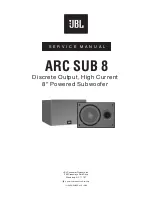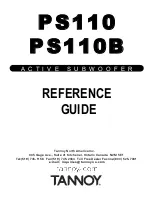
42
|
Australian Hi-Fi
42
|
Australian Hi-Fi
test
results
equipment
review
Velodyne CHT-12Q Subwoofer
Test Results
Velodyne’s CHT-12Q Subwoofer proved to
have a very flat and extended response in the
Jazz/Classical position, which is shown in
Graph 1
. This trace, measured at three metres,
using pink noise as the test signal, is shown
unsmoothed (red trace) and smoothed to one-
third octave (black trace). You can see that
the frequency response extends from 30Hz
to 130Hz ±3dB. Velodyne specifies response
as 25Hz to 120Hz ±3dB, so you can see that
Newport Test Labs’
result shows the Velodyne
exceeds the specification at the high end,
and comes up only 5Hz short in the bass. Al-
though these differences between the spec and
the measurement are so small as to be com-
pletely insignificant, I should point out that
the ‘Movies’ preset boosts the low bass consid-
erably, so that using the ‘Movies’ equalisation
preset extends the bass down to 20Hz within
the ±3dB tolerance. (The lift is shown clearly
on
Graph 3
, and this trace is of the bass driver
only, without the contribution from the bass
reflex port.)
The second graph (
Graph 2
) shows the
nearfield responses of the bass driver and
the slot-shaped bass reflex port. You can see
that Velodyne’s engineers have got the port
working beautifully, with its maximum output
almost shelved between 30Hz and 50Hz. The
roll-off at high frequencies is smooth and
controlled and almost identical to the woofer
roll-off, so the re-inforcement between the
two is perfect. The roll-off below 30Hz is also
well-contoured.
Graph 3
shows the equalisation applied
by using the different presets, as well as the
differences in level between them. You can see
that if you are listening to the Jazz/Classical
preset (black trace) and switch to any of the
others, you get not only different frequency
contouring, but also a boost in output level.
Obviously the boost varies with frequency but
on average the increase is around 2.5dB. Note
that all these traces are of the bass driver only:
the contribution from the port has not been
factored in as it has been in
Graph 1
.
The final graph (
Graph 4
) shows the effect
on the frequency response of the bass driver
of using the maximum and minimum settings
of the low-pass filter. This shows exactly
what I would have expected, so Velodyne’s
specifications are spot-on. Although the port’s
output is shown on this graph, you should
note that its output has not been scaled to
compensate for the difference in radiating
area between it and the bass driver. However,
the extended horizontal scale of this graph,
compared to the other three graphs, has the
advantage of showing that the bass reflex port
does not produce any unwanted resonances
or ‘leaks’ at high frequencies. Overall, an
excellent set of results.
Steve Holding
It’s important to remember that hav-
ing an onboard subwoofer calibration
system such as the one that is fitted to
Velodyne’s CHT-12Q is not a universal
panacea. If you put any subwoofer with
an automatic equaliser in a position in
the room for which it’s totally unsuited,
the circuit will be able to make the best
of it, but you’d be far better advised to
first find the position in the room where
the subwoofer sounds the best, and then
use the circuitry to make a good thing
even better.
The two main culprits that affect the
response of any subwoofer are room
modes (eigentones) and room load-
ing. Let’s look at loading first. If you sus-
pended an EQ-equipped subwoofer in
the middle of your room, well clear of any
boundaries, the computer would quickly
work out that this was a terrible position
and would dial in maximum low bass
boost. This means the internal amplifier
would likely be working flat-out
all
the time, with the result that dynamics
would suffer. Obviously, in a real situation,
the subwoofer will at least be sitting on
the floor, so the low bass will be helped
along by being close to one boundary.
However, if you move an EQ-equipped
subwoofer close to a wall, so it’s interact-
ing with two boundaries, it will deliver even
more bass as a result, so less equalisation
would be required and the internal am-
plifier would have to work less hard. If you
place the subwoofer in a corner, where it
would ‘see’ three boundaries, the com-
puter would then very likely be able to at-
tenuate volume at low frequencies, rather
than boost it, which would have the effect
of freeing up amplifier power, and increas-
ing dynamic ability.
As for eigentones, they’re what result
when low frequencies interact with the phys-
ical dimensions of your room, so they’re very
difficult to eliminate—or even modify—with-
out resorting to moving walls and raising
ceilings.
The best way of dealing with them is to
use multiple subwoofers (at least two,
but ideally four!) but since this solu-
tion doesn’t appeal to many people
for reasons of both cost and aesthet-
ics, the next best option is to position
the subwoofer where you don’t excite
any. The only way to do this is by putting
the subwoofer in all the places you’d
like it to go, and choosing the position
where it sounds the best, and this is the
technique you’ll need to use with all
subwoofers, no matter whether they’re
equipped with auto-equalisation cir-
cuits or not.
Location, Location, Location





















